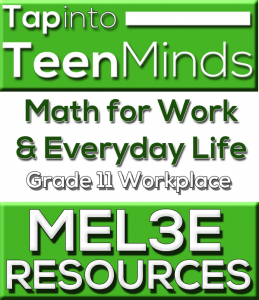MEL3E Grade 11 Math Course Description
 This MEL3E grade 11 math course enables students to broaden their understanding of mathematics as it is applied in the workplace and daily life. Students will solve problems associated with earning money, paying taxes, and making purchases. Apply calculations of simple and compound interest in saving, investing and borrowing; and calculate the costs of transportation and travel in a variety of situations. Evaluate the pros and cons of situations from simple purchases, discount purchases, or investments.
This MEL3E grade 11 math course enables students to broaden their understanding of mathematics as it is applied in the workplace and daily life. Students will solve problems associated with earning money, paying taxes, and making purchases. Apply calculations of simple and compound interest in saving, investing and borrowing; and calculate the costs of transportation and travel in a variety of situations. Evaluate the pros and cons of situations from simple purchases, discount purchases, or investments.
Students will consolidate their mathematical skills as they solve problems and communicate their thinking.
Prerequisite: Principles of Mathematics, Grade 9, Academic, or Foundations of Mathematics, Grade 9, Applied, or a ministry-approved locally developed Grade 10 mathematics course.
Material provided below was created by Kyle Pearce and Chris Tavolieri. If you make improvements to the material, please share back so we can post a link.
MEL3E Grade 11 Math Course Notes and Handouts
MEL3E – Unit 1 – Working and Earning
Sec. 1.3 – Hourly Rate and Overtime Rate
MEL3E – Unit 2 – Deductions and Expenses
| Sec. 2.1 – Standard Deductions – Note Sec. 2.1 – Standard Deductions – Handout |
| Sec. 2.2 – Other Deductions |
| Sec. 2.3 – Living Expenses |
| Sec. 2.4 – Paying Monthly Bills |
| Sec. 2.5 – Purchasing Power |
MEL3E – Unit 3 – Paying Taxes
Sec. 3.1 – Information for Filing Income Taxes
Sec. 3.2 – Sales Tax – Worksheet
Build your educator content knowledge related to tax minimization strategies and wealth preservation.
MEL3E – Unit 4 – Making Purchases
Sec. 4.2 – Getting Back Fewer Coins
Sec. 4.3 – Taxes and Total Cost
Sec. 4.4 – Discounts and Sale Prices
Sec. 4.5 – Sale Prices, Taxes, and Total Cost
MEL3E – Unit 5 – Buying Options
Sec. 5.3 – Cross Border Shopping
Sec. 5.4 – Decision to Buy -Layaway
Sec. 5.5 – Instalment Plans Without Interest
Sec. 5.6 – Pay Later With Penalty
MEL3E – Unit 6 – Banking Transactions & Saving Money
Sec. 6.1 – Banking Transactions
Sec. 6.3 – Simple Interest – Note
Sec. 6.3 – Simple Interest – Worksheet
Sec. 6.4 – Simple and Compound Interest
Sec. 6.5 – Compound Interest – Note
Sec. 6.5 – Compound Interest – Worksheet
Learn how you can teach students about the power of compound interest.
MEL3E – Unit 7 – Types of Investing
Sec. 7.1 – Types of Investments
Sec. 7.2 – Registered Retirement Savings Plans
Sec. 7.4 – Risk Tolerance – Type of Investor
Sec. 7.5 – Application of Types of Investing
Learn about real estate investing and other asset classes.
MEL3E – Unit 8 – Taking a Trip
Sec. 8.1 – Taking a Trip Introduction – Gas Consumption
Sec. 8.1 – Taking a Trip Introduction – Gas Consumption Information
Sec. 8.1 – Taking a Trip Introduction – Time Calculations
Sec. 8.2 – Planning a Trip by Automobile
Sec. 8.3 – Planning a Trip – Train vs. Car
MEL3E – Unit 9 – Personal Finance
Sec. 9.2 – Delaying Payment on Credit Cards
Sec. 9.3 – Short-Term Borrowing
MEL3E – Unit 10 – Buying a Car
Sec. 10.3 – Depreciation of Cars
Sec. 10.4 – Irresponsible Driving – Worksheet
Sec. 10.4 – Irresponsible Driving – Facts
Sec. 10.5 – Car Versus Public Transportation
This course is a fantastic course for students to gain a wealth of knowledge in all things personal finance. However, if you as the educator are not confident in this area, that can be problematic. Learn about different wealth building strategies here including a fantastic list of the best investment and wealth building books so you can provide your students with the best learning opportunity you can.
